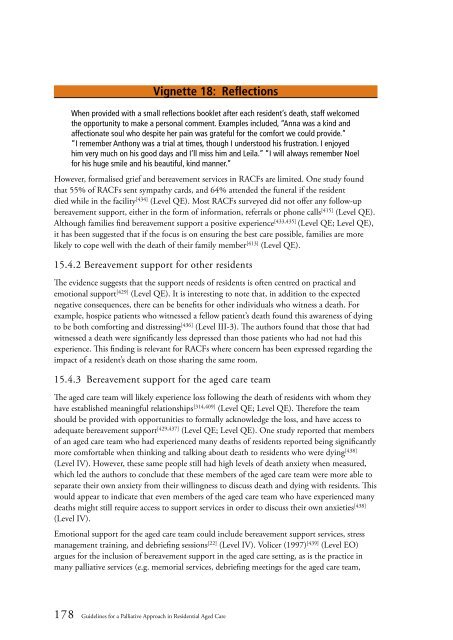Guidelines for a Palliative Approach in Residential Aged Care
Guidelines for a Palliative Approach in Residential Aged Care
Guidelines for a Palliative Approach in Residential Aged Care
Create successful ePaper yourself
Turn your PDF publications into a flip-book with our unique Google optimized e-Paper software.
Vignette 18: Reflections<br />
When provided with a small reflections booklet after each resident’s death, staff welcomed<br />
the opportunity to make a personal comment. Examples <strong>in</strong>cluded, “Anna was a k<strong>in</strong>d and<br />
affectionate soul who despite her pa<strong>in</strong> was grateful <strong>for</strong> the com<strong>for</strong>t we could provide.”<br />
“I remember Anthony was a trial at times, though I understood his frustration. I enjoyed<br />
him very much on his good days and I’ll miss him and Leila.” “I will always remember Noel<br />
<strong>for</strong> his huge smile and his beautiful, k<strong>in</strong>d manner.”<br />
However, <strong>for</strong>malised grief and bereavement services <strong>in</strong> RACFs are limited. One study found<br />
that 55% of RACFs sent sympathy cards, and 64% attended the funeral if the resident<br />
died while <strong>in</strong> the facility [434] (Level QE). Most RACFs surveyed did not offer any follow-up<br />
bereavement support, either <strong>in</strong> the <strong>for</strong>m of <strong>in</strong><strong>for</strong>mation, referrals or phone calls [415] (Level QE).<br />
Although families f<strong>in</strong>d bereavement support a positive experience [433,435] (Level QE; Level QE),<br />
it has been suggested that if the focus is on ensur<strong>in</strong>g the best care possible, families are more<br />
likely to cope well with the death of their family member [413] (Level QE).<br />
15.4.2 Bereavement support <strong>for</strong> other residents<br />
The evidence suggests that the support needs of residents is often centred on practical and<br />
emotional support [429] (Level QE). It is <strong>in</strong>terest<strong>in</strong>g to note that, <strong>in</strong> addition to the expected<br />
negative consequences, there can be benefits <strong>for</strong> other <strong>in</strong>dividuals who witness a death. For<br />
example, hospice patients who witnessed a fellow patient’s death found this awareness of dy<strong>in</strong>g<br />
to be both com<strong>for</strong>t<strong>in</strong>g and distress<strong>in</strong>g [436] (Level III-3). The authors found that those that had<br />
witnessed a death were significantly less depressed than those patients who had not had this<br />
experience. This f<strong>in</strong>d<strong>in</strong>g is relevant <strong>for</strong> RACFs where concern has been expressed regard<strong>in</strong>g the<br />
impact of a resident’s death on those shar<strong>in</strong>g the same room.<br />
15.4.3 Bereavement support <strong>for</strong> the aged care team<br />
The aged care team will likely experience loss follow<strong>in</strong>g the death of residents with whom they<br />
have established mean<strong>in</strong>gful relationships [314,409] (Level QE; Level QE). There<strong>for</strong>e the team<br />
should be provided with opportunities to <strong>for</strong>mally acknowledge the loss, and have access to<br />
adequate bereavement support [429,437] (Level QE; Level QE). One study reported that members<br />
of an aged care team who had experienced many deaths of residents reported be<strong>in</strong>g significantly<br />
more com<strong>for</strong>table when th<strong>in</strong>k<strong>in</strong>g and talk<strong>in</strong>g about death to residents who were dy<strong>in</strong>g [438]<br />
(Level IV). However, these same people still had high levels of death anxiety when measured,<br />
which led the authors to conclude that these members of the aged care team were more able to<br />
separate their own anxiety from their will<strong>in</strong>gness to discuss death and dy<strong>in</strong>g with residents. This<br />
would appear to <strong>in</strong>dicate that even members of the aged care team who have experienced many<br />
deaths might still require access to support services <strong>in</strong> order to discuss their own anxieties [438]<br />
(Level IV).<br />
Emotional support <strong>for</strong> the aged care team could <strong>in</strong>clude bereavement support services, stress<br />
management tra<strong>in</strong><strong>in</strong>g, and debrief<strong>in</strong>g sessions [22] (Level IV). Volicer (1997) [439] (Level EO)<br />
argues <strong>for</strong> the <strong>in</strong>clusion of bereavement support <strong>in</strong> the aged care sett<strong>in</strong>g, as is the practice <strong>in</strong><br />
many palliative services (e.g. memorial services, debrief<strong>in</strong>g meet<strong>in</strong>gs <strong>for</strong> the aged care team,<br />
178 <strong>Guidel<strong>in</strong>es</strong> <strong>for</strong> a <strong>Palliative</strong> <strong>Approach</strong> <strong>in</strong> <strong>Residential</strong> <strong>Aged</strong> <strong>Care</strong>
















